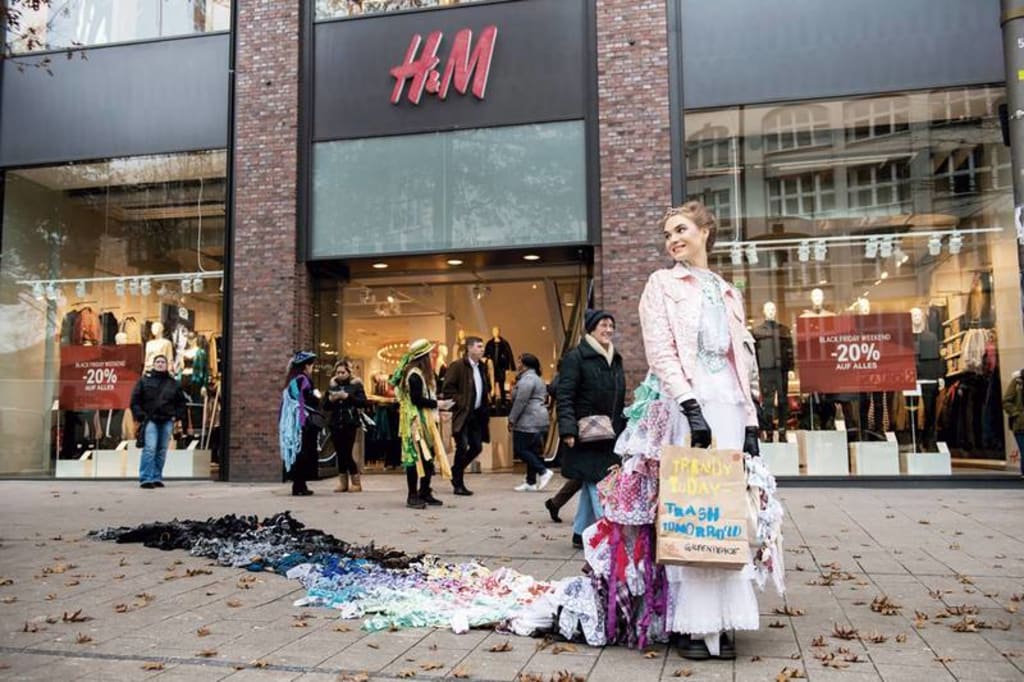Fast Fashion and the Effects it has on the Environment and How We can Save our Planet.
Research Paper

Fashion in general is defined as “the making or shaping of the appearance of the body by means of clothing and adornment in a way that expresses aesthetic ideals that are continually subject to change” according to an article titled ‘Fashion: Origins and Development’ written by Lourdes Font and Beth McMahon. Before the 1800s, the creation of clothing was a slow process, as sheep were farmed for wool and that wool was weaved and slowly turned to shirts, dresses and pants. Thankfully, during the Industrial Revolution new textile machines and factories were created in which sped up the process of clothing production according to an article titled ‘Fashion History Lesson: The Origins of Fast Fashion’ by Sara Idacavage. Fast fashion is dated back to 1989 when Anne-Marie Schiro wrote an article, where she talks about the opening of Zara in New York. She calls the Spanish company a ‘fast fashion’ one since the store is restocked every three weeks with the latest trends in which everyone wanted a taste of according to an article titled ‘Two New Stores the Cruise Fashion’s Fast Lane’ written by Anne-Marie Schiro. In addition, H&M opened its first store in the US in 2000 and that was another revolutionary beginning for fast fashion companies as Americans began to believe that cheap is chic and this idea was globalized according to Ruth La. Ferla in the article ‘’Cheap Chic’ Draws Crowds on 5th Ave’.
Problems Associated with Fast Fashion
There are a variety of problems associated with fast fashion companies and how the creation of fast fashion clothing affects the environment negatively. Firstly, something that has been discovered about fast fashion companies is that they have been known for victimizing and exploiting their workers. Companies such as H&M, Zara and Forever 21 have been known for using sweatshops where their employees are paid poorly and are working in hazardous environments according to ‘The Good, The Bad, The Ugly Side of Fast Fashion’ written by Lara Hamdan. What’s even more tragic is that women in these factories are victims of abuse as so many have reported of incidents where they are bullied, slapped and some even raped. They work for some many hours, are underpaid and are even prevented sometimes from taking bathroom breaks. Some women spoke publicly about their experiences and one of them is called Radhika, who was employed at a H&M factory in Bangalore, India. She bravely came out and described what her supervisor did to her: “He pulled me out of the chair, and I fell on the floor. He hit me, including on my breasts. He pulled me up and then pushed me to the floor again [and] kicked me”. After this, she filed a complaint against him, but such actions and behaviors failed to end in these sweatshops, and women, like Radhika, had to remain silent while suffering in their atrocious work environments. The small price we pay for the clothes these companies and stores sell, is because of their employees who are paying the bigger price for us to have these clothes.
Another problem associated with fast fashion is the negative impact it’s having on our planet and our atmosphere in which we are breathing daily. There is rapid and high production of clothing in the factories of fast fashion companies and this means there is a lot of waste coming from this over-production and these clothes are being destroyed if they are not sold. H&M was accused of destroying 4.3 billion dollars’ worth of unworn clothing and who knows how many more companies have destroyed clothing according to an article titled ‘Fast Fashion’s Overproduction is Killing the Planet’. In addition, the clothing that is being sold to customers is bought in excessive amounts because as humans we want to splurge, and this leads to clothing being forgotten and left in closets until they are thrown out. Throwing out clothes is the biggest crime you commit when it comes to harming the environment. Those clothes end up in landfills and take a long time to be broken down since they are usually made from non-biodegradable material. When they are finally broken down, they release greenhouse gases which are toxic to the environment according to an article titled ‘Nine Reasons You Shouldn’t Throw Away Clothes’ written by Ally Hirschlag. It is very common for people to throw things in the trash, we have all done it, whether it was because there was no time to drop them off, or something looks too damages to be donated. According to the 2017 State of Reuse Report, ‘North Americans throw away roughly 81 pounds of textiles a year per person’ like clothing, towels bedding etc. That’s more than 26 billion pounds heading into landfills each year across the US and Canada. What is happening to our planet and what we are doing to it is terrifying but there are ways to attempt and do better for it.
Solutions
There are many alternatives to fast fashion shopping that are more environmentally friendly and ethically correct. The most popular alternative are thrift stores/secondhand stores that are now very trendy in the 21st century, making it easier for youngsters to shop at these stores. Thrift stores are stores that sell previously used clothing, furniture and other items at a lower price. It is a way of giving previously owned items a new life according to an article titled ‘What does it Mean to Go Thrifting’ by Goodwillaz.org . There are a lot of such stores in Brooklyn and Manhattan where a lot of fashionably inspired people, especially college students, get most of their clothes from. For example, in the East Village there’s a small shop named AuH20 which is usually packed with cheap gems and its overall an aesthetic and cute shop. The main good thing about thrift stores is that they are cheap and since different fashion styles come and go over the years, old clothes become ‘vintage’ and regain their life and value.
Another alternative to fast fashion shopping is borrowing clothes from relatives or friends when we want something new in our closets. Exchanging clothing with people we know is also a nice way to bond with them. Luckily for me I’m the same size as my mother and whatever she considers not her style anymore for her, she gives it to me and my sister, instead of throwing them out. This ensures that the clothing she purchased years ago will be put to good use and not end up in landfills. If more people start borrowing from family members and friends, then clothes will keep on being re-used and revived instead of ending up in landfills.
Another great way to avoid fast fashion shopping is to go online on Depop and ThredUp which are websites where you can sell or purchase secondhand clothing that are usually in great condition and you save the planet in the process. Online thrifting is an easy way to purchase items and clothing for a cheaper price and you get the same comfort you get when you shop online in fast fashion websites.
In addition, besides the alternatives to fast fashion way fast fashion companies can avoid waste and harming the environment, is to “maintain some level of markdown inventory” and as a result does not overproduce clothing and sell more than just 60% of what they produce. Also, they can use more organic material to create their clothing. Zara’s parent company Inditex announced that until 2025 all its brands will only use organic, sustainable, or recycled materials.
Pros and Cons to the Solutions.
Thrift stores have positives and negatives and it’s good to evaluate both to explore if it can actually replace fast fashion shopping. Thrift stores can be a perfect alternative to fast fashion shopping for various reasons. Firstly, thrift stores allow clothing that was once old or outdated to be re-sold one day when they’re back in fashion and this clothing goes from being called ‘old’ to ‘vintage’. Secondly, thrift stores limit waste and pollution as clothing is donated and re-sold instead of being thrown out. Clothing is ‘recycled’ and re-used constantly, and this saves our planet from greenhouse emissions. Thirdly, thrifting is better than buying clothes from fast-fashion shops as they are better in quality but also cheaper because they have been previously used. You can get an amazing deal for a once previously expensive outfit for a cheaper price than it once was.
Besides the many advantages of thrifting there are also some negatives to it. Usually, thrift stores are limited in sizes and colors and this means that not everyone will get the chance to find what they need and in the size they need it in. In addition, fights can sometimes take place in thrift stores because 2 or more people can argue and fight over an item since items are so limited and one of a kind. Secondly, thrift stores tend to lack organization and it may be hard and tricky to find something you like in a disorganized and untidy store. Thrift stores are usually not as tidy as fast fashion stores because people tend to not take very good care of them whether it’s the owners or customers, but some stores are very clean and impressive making it seem like it’s not a thrift store. Also, some people are not up for the challenge of thrifting which consists of a deep search for the right item and the correct size and it can take around 1-2 hours to complete the shopping spree, whereas in fast fashion stores you can find the latest trends in a variety of colors and sizes, and you usually can take only 20-30 minutes with shopping in a fast fashion store.
Another alternative to fast fashion shopping is borrowing from and exchanging clothes with relatives and friends. There are several benefits to exchanging clothing with people you know, including how getting together with a bunch of friends and exchanging clothing could be very fun. Clothing swaps save you money as you’re trading something you bought a while ago for something that your friends owned and is essentially new to you. By organizing a clothing swap party you’re encouraging sustainable behavior and promoting such parties. These parties can bring people close together as the theme of clothing is a part of everyone’s lives and everyone has desired clothes to wear and to buy, so doing an exchange with no money involved could be a fun activity and fair trade.
However, there are also some negatives regarding clothing swapping including how some people might not get what they need from their friends or family and even though they may grab your clothes which may be in excellent quality, you may end up with something completely different and with something you did not expect.18 Hence, some clothing swaps can be unsuccessful because certain people may offer high quality clothing for the swap but leave with nothing or with not as good quality clothing, which can end up being disappointing.
Another alternative to fast fashion shopping would be online thrifting websites like Depop and ThredUp which are pretty much the same as thrifting but online. There are several advantages to online thrifting including how it can take place in your own house where you don’t have to move a muscle (except your finger) and people that don’t want to go out of their way and commute to thrift stores, which are limited in some places, can search in the comfort of their own home. In addition, online thrift stores are usually more organized than most actual thrift stores, which can be untidy, since they have categories and subcategories to break down where each clothing and item is. This offers easy and good accessibility to customers that are looking for a certain item and not just browsing. Also, customers don’t have to fight over an item, which tends to happen since there could be a one-of-a-kind item in the whole store, and so once you put it in your basket then it’s saved for a couple of hours and no one is allowed to purchase it in the meantime.
There are also some cons to online thrifting, however, include how customers can’t see the item up close and only through pictures that are made available to them. This means that you may purchase something you don’t really want or something that is not as good quality as it seemed. In addition, there are also extra shipping charges usually along with the price of the items, which sometimes can be more expensive than the item itself.
Another solution that can aid with limiting fast fashion distribution and shopping is for companies that are overproducing to limit their over-production. If companies attempted to limit their over-production, there won’t be any excess items and products created and materials wasted. In this way, there won’t be over-production or over-purchasing. There are several advantages to limiting production. Firstly, if companies don’t overproduce there will be less waste and most of their clothes that will be produced will be sold, avoiding pollution and clothes ending up in landfills. Hence, clothing that is not desired as much as others, will not be totally wasted if it’s not overproduced. Controlling and watching production will ensure that unsold inventory will not be overflowing, and hence there will be less waste created by these companies. There aren’t many disadvantages for this solution as fast fashion companies need to stop overproduction and if this is controlled, fast fashion won’t be such a huge problem.
Another way to sustain the environment is for fast fashion companies to use organic and sustainable materials to create their clothing. The advantages to using organic and sustainable materials to create clothing are that ensures the safety of the planet as these materials are bio-degradable and will be able to be broken down by the environment and not release toxic waste. In addition, it was discovered that fibers in our clothing could be harming the sea world and as a result our food supply and therefore, if we create clothes using organic cotton then our sea world won’t corrupt and take us down with it. There are also disadvantages regarding the creation of sustainable clothing. The natural
materials needed for the creation of sustainable clothing are more expensive than synthetic materials which are created by chemicals. Moreover, ethically run facilities pay their employees fairly and well, meaning they lose a lot of money from the creation of sustainable clothing. In addition, they allow basic human rights such as bathroom breaks and a certain amount of work hours which means that the companies lose time from creating sustainable clothing.
Conclusion
Fast fashion is unethical and not environmentally friendly, due to what comes out of the materials used in the clothing distributed and the circumstances in which their employees work in. Fast fashion companies are failing because they are overproducing and overselling, and if they’re not selling enough then the leftover clothing ends up in landfills. However, fast fashion companies can use biodegradable materials and organic materials in order to avoid any toxic chemicals to be released in the atmosphere. In addition, the workers should be offered better conditions to work in in order to make fast fashion companies more ethical.
About the Creator
Natalie G.
Instagram: _nataliesenses_






Comments
There are no comments for this story
Be the first to respond and start the conversation.